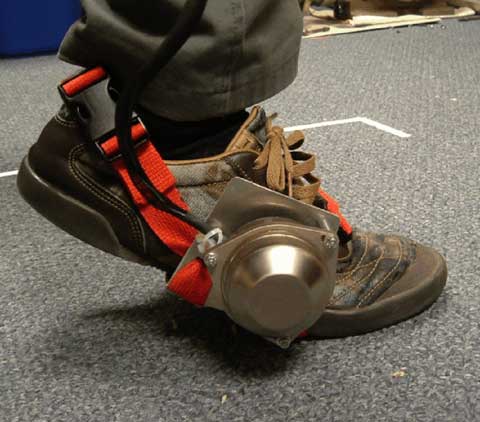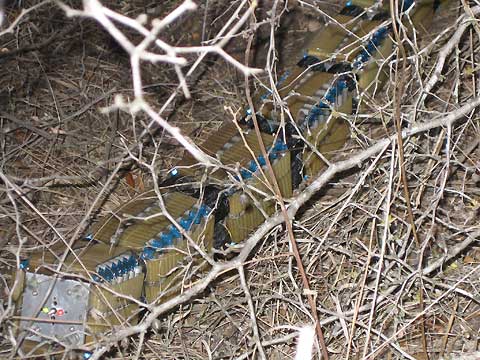Two teams from MEs Mobile Robotics Laboratory walked away from a recent conference, awards in hand. The Mobile Robotics Lab’s Personal Odometry System (POS) earned the “best in show” designation at the American Nuclear Society’s 2006 International Joint Topical Meeting: Sharing Solutions for Emergencies and Hazardous Environments. The team also earned a $1,000 prize. At the same event, held in February, the lab’s OmniTread OT-4 serpentine robot garnered the Technology Innovation Award and a $500 cash prize.

The BAE SiIMU02 “inertial measurement unit” mounted to the foot of a walking subject.
The POS measures and tracks the location and trajectory of a walking person relative to a known starting position, such as the entrance to a building. The system could be used by nuclear security personnel and emergency responders. For example, the movements of security staff inside a building where GPS is not available could be tracked, as could the location of fire fighters inside a burning building. The POS would wirelessly relay the users positions to a central command post in real-time.
Currently the POS is comprised of a three-axis gyroscope and a three-axis accelerometer, together referred to as an inertial measurement unit (IMU). The user wears the IMU on the outside of a shoe or boot, a less-than-ideal solution, acknowledges Research Professor Johann Borenstein, who directs the Mobile Robotics Lab. However, a smaller, MEMS-based IMU would allow the unit to be embedded in the sole of the user’s shoe. The team will be moving to such a micro-electro-mechanical system within the next six to twelve months.
Data from the accelerometer is used by the POS to compute linear displacement, something most accelerometers cannot measure because of errors from bias-drift. But given the lab’s 20-plus-years’ experience in non-GPS navigation with mobile robots, it has developed a practical method for correcting bias drift. The correction works under certain operational conditions, including legged motion such as walking, running and climbing.
The ANS conference was not the first time the Mobile Robotics Lab’s POS held a public performance. At a conference in Michigan in June 2005, a subject outfitted with the POS walked along a hall, up two flights of stairs, along another hall, down a different staircase and back to the starting point. The unit recorded the trip with “impressive accuracy,” says Borenstein. In August 2005 the POS was demonstrated at the National Urban Search and Rescue Conference, organized by the Federal Emergency Management Agency. The POS was the subject of much attention and interest there.

The OmniTread OT-4, Technology Innovation Award winner at the ANS conference, is a snake-like robot that rolls along the ground and propels itself forward much like an inchworm. Weighing eight pounds, the robot includes seven segments, each about four inches long and almost completely covered by tracks, allowing it to be indifferent to roll-overs. The tracks also create propulsion wherever they touch the environment, especially useful in navigating rubble or dense underbrush.
Pneumatic bellows actuate the joints between segments, which gives the OmniTread “tremendous force” there, explains Borenstein. It also allows complete control of the stiffness of each joint–maximum stiffness is best-suited for spanning wide gaps, while minimum stiffness allows the robot to conform to terrain. Conventional serpentine robot design incorporates electrically driven, rather than pneumatically actuated joints, and it’s difficult, if not impossible, to control the stiffness in such joints during motion.
Another innovation is the single motor in the center segment that powers a central drive shaft spine and provides torque to all tracks. Having a single on-board motor, rather than one per segment as conventional designs do, optimizes weight distribution and reduces energy consumption.
During testing, the OmniTread OT-4 has crossed railroad tracks and maneuvered rocky ground, dense grasses, a 16-inch curb, a two-foot trench and a flight of stairs. It can pass through a four-inch diameter hole and selectively disengage individual tracks from the drive shaft spine, saving power.
The OT-4 does not require a tether for electric power or compressed air. It can be controlled wirelessly. Electric energy for over one hour of operation is provided by onboard Li-Polymer batteries, and an onboard compressor provides pneumatic power.
Like the Personal Odometry System, the OT-4 has numerous applications, including aiding with inspection of nuclear facilities and oil refineries to surveillance in combat zones and urban search and rescue, says Borenstein. “When you’re searching for survivors in a collapsed building, you need all of the tools you can possibly have.”